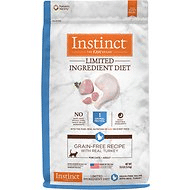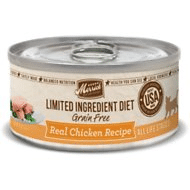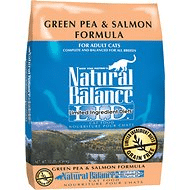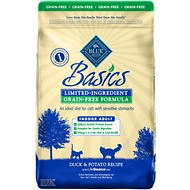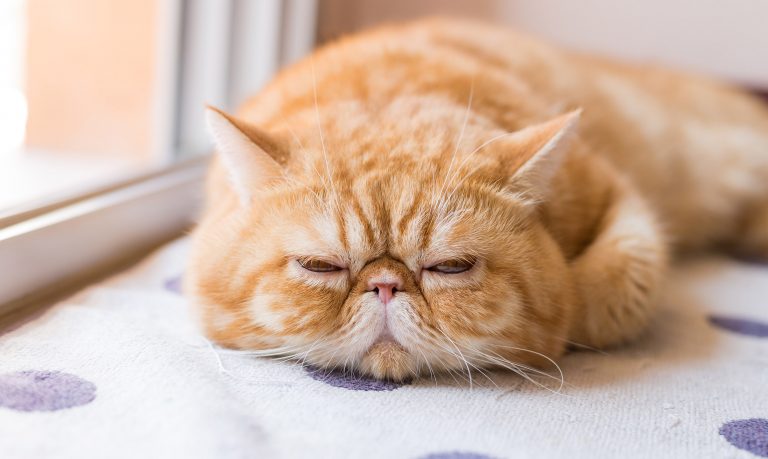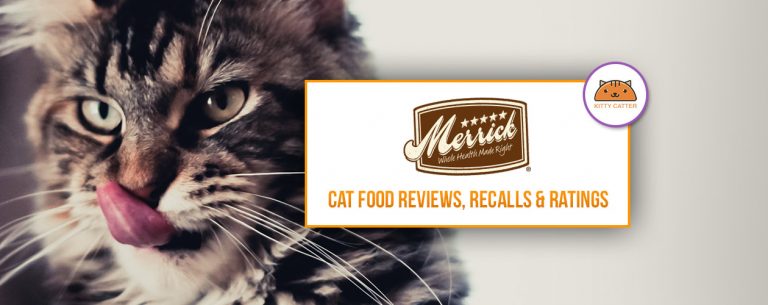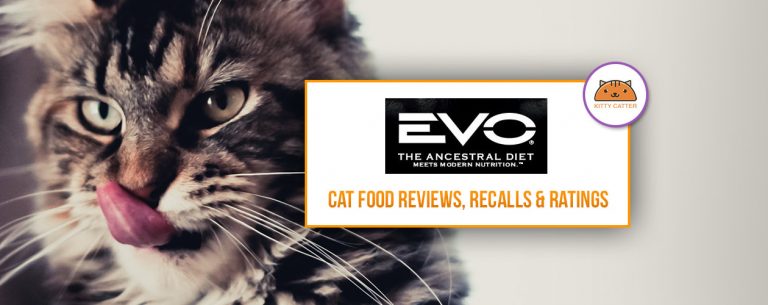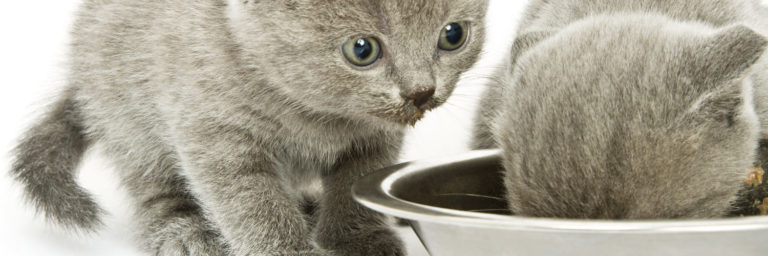Best Hypoallergenic Cat Food
Contents of Article
Contrary to what many people believe, food allergies are relatively uncommon in pets. It’s estimated that between 5 and 15 percent of cats have a food allergy. Food allergies are not as much of a problem for cats as they can be for dogs, but they are still problematic when they occur. Your cat can experience terrible itching, skin problems, ear infections, and in some cases gastrointestinal troubles. It’s important to identify the allergen(s) that trigger your cat’s allergic reactions and try to avoid them. Feeding a hypoallergenic cat food can be very helpful in many cases.
(Note that one source suggests that cats have more problems with food allergies than dogs, but every other veterinary source consulted states that dogs have more problems with food allergies than cats.)
Symptoms of a food allergy in cats
Common symptoms of a food allergy for a cat include the following:
- Itchy skin, especially around the face, paws, and ears
- Bad odor from the skin
- Ear infections
- Excessive scaling
- Red bumps on the skin
- Self-inflicted trauma to the skin due to severe itching and scratching
- Loss of hair
Gastrointestinal issues such as diarrhea and vomiting can also occur but they are not common. They occur in an estimated 10 to 15 percent of cats that have a food allergy.
Many of these symptoms are part of a chain reaction. For example, if your cat is allergic to something he is eating, his body will have a histamine response which causes itching and can cause red bumps on the skin. Your cat scratches his skin which can lead to the trauma (injury) such as lesions or sores. This can lead to hair loss. All of this can make the skin smell bad. And the itching will continue, making your cat scratch at his damaged skin even more. It’s an endless cycle until your poor cat gets some treatment and relief. Finding a food he can safely eat that doesn’t contain any allergens as triggers will help a lot, but if your cat has created a lot of sores on his body and they have become infected, your vet may also need to treat him for any infection.
Quick Look : Top 4 Best Hypoallergenic Foods For Cats
Food allergens
The most common food allergens for cats may be different than you expect. Allergens are proteins and since cats usually have more meat in their diet, they are more likely to have allergies to meat proteins. According to a 2006 study, the most commonly identified food allergens for cats are as follows (from greatest to least):
- Beef – 20%
- Dairy – 14.6%
- Fish – 13%
- Lamb – 6.7%
- Poultry – 4.5%
- Barley/Wheat – 4.5%
This probably goes against what most people expect but some cats can be allergic to dairy (including milk) or fish, which everyone assumes is a perfect food for cats. Wheat and other grains are not a major cause of allergies in cats. You may wish to feed a grain free cat food for other reasons, but feeding a grain free cat food is not necessarily a way to avoid allergens.
Identifying your cat’s allergy
If you suspect that your cat has a food allergy, the best way to confirm it is by using an elimination diet in a food trial. There are blood tests available to help determine food allergies but they can be unreliable, according to veterinary dermatologists. However, Dr. Jean Dodds (and associates) have developed a way to test your cat (or dog) for food intolerances and sensitivities using a saliva sample. They can test for 24 different foods. This is for food sensitivities and intolerances. It will not tell you if your cat is allergic to something. The two things produce different responses. But it appears to be a useful test. Note that you can usually tell the difference between an allergy and a food intolerance by the symptoms. Allergies usually produce itching and skin problems. Food intolerances and sensitivities usually produce gastrointestinal problems such as vomiting and diarrhea. Another difference between the two is that your cat would have to be exposed to an allergen for a little while before his body would produce a reaction to it. If your cat is intolerant or sensitive to a food, he can react the very first time he eats it.
Since blood tests are often considered to be unreliable when identifying allergens, an elimination diet can help you identify your cat’s allergen(s). The best way to conduct an elimination diet is by working with your veterinarian and using a diet that only has one kind of protein which your cat has never eaten before. Ideally this will be a hypoallergenic or limited ingredient diet that doesn’t have any ingredients your cat has eaten before. You may need to feed a prescription diet in order to meet these criteria. Feed this diet for 8-10 weeks and see if your cat’s symptoms get better. If they do, your vet will probably want to “challenge” your cat by starting to add some foods/ingredients back into his diet to see if or when your cat has a reaction. This will help pinpoint exactly what your cat is allergic to. Using this process you and your vet can find out what items to avoid when you are trying to find a food for your cat for the long term.
Choosing a food
There are several prescription hypoallergenic diets that you can obtain through your vet while you are conducting this food trial. You should be able to choose a wet or dry food for your cat. Although there are over-the-counter hypoallergenic foods (and some of them are quite good), when you are at the stage of trying to identify the allergens that trigger your cat’s allergy, it’s really best to use a prescription hypoallergenic food. Many times pet foods sold off the shelf, even super premium foods, will contain ingredients that are not listed on the label and one of these ingredients could trigger your cat’s allergy. (As we have said elsewhere, don’t look too closely at the ingredients when you have to buy a prescription cat food. You probably won’t like everything you see on the label. However, prescription foods, when you need them, usually have benefits that make them worthwhile, at least on a temporary basis.)
Some prescription hypoallergenic cat foods are made with hydrolyzed protein. Basically, this means that the protein in the food has been broken down to such an extent that your cat’s gastrointestinal system can’t even identify what it used to be. For a cat with a food allergy, this is a good thing. If your cat’s body can’t identify what kind of protein it is, it won’t mount an allergic reaction.
You can also feed your cat a homemade diet during the food trial period but you would need to be very precise about what you are feeding and, preferably, consult with a veterinary nutritionist to make sure the recipes you are using are balanced. There are some good pet nutritionists available online who will consult with clients and discuss your pet’s case with your vet.
If you and your vet are able to identify the food allergen(s) during the food trial, you will probably be able to find a good over-the-counter hypoallergenic cat food to take the place of the very expensive prescription hypoallergenic cat food. There are many good hypoallergenic and limited ingredient foods for cats in specialty pet stores and from pet food retailers online. If your cat’s symptoms don’t improve after 10 weeks on the elimination diet, you can start over with a different prescription diet.
Some of the prescription hypoallergenic foods available today include the following:
- Royal Canin Hypoallergenic PD Dry Cat Food
- Royal Canin Hydrolyzed Protein Dry Cat Food
- Royal Canin Select Protein PR Dry Cat Food
- Royal Canin Select Protein PR Canned Cat Food
- Purina ProPlan Veterinary Diets HA Hydrolyzed Formula Dry Cat Food
- Hill’s Cat z/d Canned Food
- Hill’s Cat z/d Dry Food
Some commercial limited ingredient diets that help with allergies and sensitive stomaches include:
- Natural Balance L.I.D. Salmon Green Pea Dry Cat Food
- Natural Balance L.I.D. Chicken Green Pea Dry Cat Food
- Natural Balance L.I.D. Duck Green Pea Canned Cat Food
- Natural Balance L.I.D. Chicken Green Pea Canned Cat Food
- Natural Balance L.I.D. Venison Green Pea Canned Cat Food
Work with your vet to select an appropriate hypoallergenic food for your cat during a food trial. Many of the foods listed above will require a prescription from your veterinarian to buy them, but you can purchase them online from pet food retailers to save money. Once you have determined what your cat is allergic to, you don’t have to continue to feed such an expensive diet. You should be able to find a good hypoallergenic or limited ingredient diet to suit your cat’s needs.
We have to warn you that cats can develop new allergies at any time so even if you are successfully managing your cat’s current allergies, or your cat doesn’t have an allergy at the moment, it is possible that he could develop a new allergy to a food he has been happily eating all his life. This just happens. It can happen if you feed your cat the best food in the world and take the best care of him. It happens to purebreds and mixes, males and females, and cats that have been spayed/neutered or left intact. Allergies and food intolerances just happen. Right now all we can try to do is identify any foods that bother our pets and try to avoid them.


